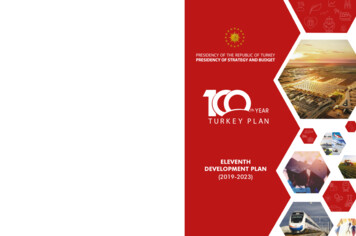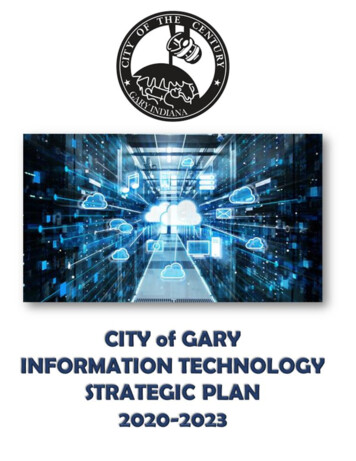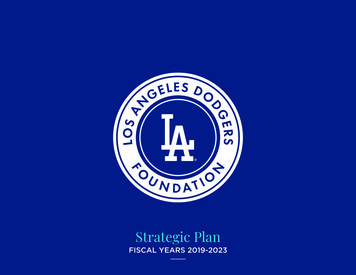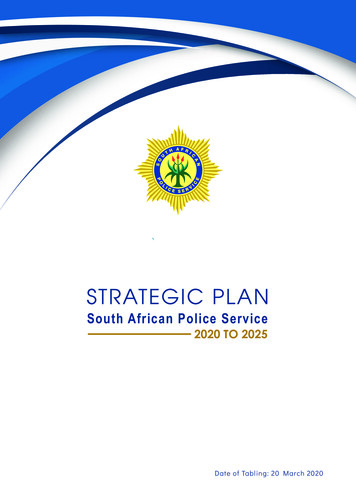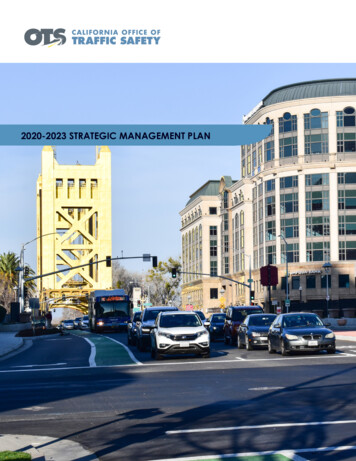
Transcription
2020-2023 STRATEGIC MANAGEMENT PLAN
Gavin NewsomGovernorState of CaliforniaDavid S. KimSecretaryCalifornia State Transportation AgencyBarbara L. RooneyDirectorCalifornia Office of Traffic Safety
CONTENTSMessage From the DirectorAbout UsVision and MissionCore ValuesProgram AreasGoal 1: LeadershipGoal 2: ServiceGoal 3: StewardshipGoal 4: Workforce DevelopmentGoal 5: Transportation Trends123451011121314
Message Fromthe DirectorI am pleased to present the 2020 – 2023 Strategic Management Plan for the California Officeof Traffic Safety (OTS).California’s OTS team is comprised of passionate and service-oriented individuals who,through their raw tenacity and innovative spirit, are determined to realize our vision of aCalifornia where every person, regardless of their mode of travel, will Go Safely. With anestimated 3,600 deaths and 13,000 serious injuries occurring annually from traffic crashes –and with 94 percent of them caused by human error - our task is great.As California assumes a leadership role in the rapidly-evolving mobility space, OTS willcontinue to explore and fund countermeasures that employ cutting edge technologies andinnovative practices to address the State’s toughest safety challenges for all road users.Achieving our vision only happens through meaningful collaboration with stakeholders atevery level. Through fostering partnerships, providing reliable data, improving our businessprocesses, and developing our team to be effective leaders in road safety, OTS iswell-positioned for the work that lies ahead.This Strategic Management Plan reflects our commitment to road safety and serves as aroadmap and vital tool to guide our actions over the next four years to bring California closerto its goal of zero traffic-related deaths.Barbara L. RooneyDirectorCalifornia Office of Traffic Safety1 California Office of Traffic Safety
About UsOTS takes a leadership role in efforts to make California roadways safe for all users. Throughthoughtful, forward-thinking, and data-driven selection of grants to local and state agencies,OTS provides an effective means of eliminating fatalities, injuries, and economic lossesresulting from crashes.Through grant funding made available to California by the National Highway Traffic SafetyAdministration (NHTSA), OTS annually funds over 80 million dollars in innovative,evidence-based education and enforcement programs and technologies designed tomake California’s roadways safer. OTS is determined to identify and overcome new trafficsafety issues as travel habits change and transportation technologies emerge. To that end,we evaluate all potential programs to ensure California addresses current and future trafficsafety needs.Our success depends on strong partnerships. We work with approximately 300 state andlocal agencies to make the most effective use of federal grant program funds. Additionally,we coordinate with traffic safety partners to track successful programs, encouragecollaboration, develop new countermeasures, and explore emerging trends.In addition to the many programs funded through these grants, the OTS team is committedto sharing the message of traffic safety. We accomplish this through public awarenesscampaigns that educate the public on safe driving habits. Our team proudly representsCalifornia as a leader in traffic safety efforts at the local, state, and national levels.2020-2023 Strategic Management Plan 2
Vision and MissionCalifornia State Transportation Agency VisionTo transform the lives of all Californians through a safe, accessible, low carbon,21st century multimodal transportation system.Office of Traffic Safety VisionEveryone traveling on California roadways will go safely.Office of Traffic Safety MissionEffectively administer traffic safety grants that deliver innovative programs andeliminate traffic fatalities and injuries on California roadways.3 California Office of Traffic Safety
Core ValuesSERVICEWe take pride in our service and how we treat our partners andstakeholders.RESPECTWe value differing opinions and act with integrity andresponsiveness in all of our interactions.INNOVATIONWe welcome and actively seek new ideas to improve traffic safetyand our services.PASSIONWe are enthusiastic about our mission to save lives and keeptravelers safe on California’s roads.2020-2023 Strategic Management Plan 4
Program Areas15ALCOHOL-IMPAIRED DRIVINGDRUG-IMPAIRED DRIVINGAlcohol-impaired driving remains one ofthe biggest threats to public safety andwell-being on our roadways. In 2018, 30% ofall traffic deaths in California werealcohol-related. OTS-supported programsfocus on education, enforcement, andprevention measures. The programs informthe public of the actions they can take toavoid this dangerous behavior as well asdeter people from driving when they areimpaired. Grant programs includeenforcement operations dedicated tostopping and arresting suspected impaireddrivers, purchase of equipment such asbreath testing devices, monitoring andtreatment of high-risk DUI offenders, andyouth education programs for high schooland college students on the dangers andconsequences of impaired driving.Drug-impaired driving is one of thetoughest safety challenges we face onroadways. The number of drivers under theinfluence of drugs, or a combination ofdrugs and alcohol, is on the rise.Prescription drugs, over-the-countermedications, marijuana, and illegal drugsmay affect one’s driving ability, especiallyin combination with alcohol or other drugs.A recent report by the Governors HighwaySafety Association found that in 2016, moredrivers killed in crashes tested positive fordrugs (44%) than alcohol (38%). Measuresto address the issue include increasedofficer training in identifying and detectingdrug impairment in drivers through theAdvanced Roadside Impaired DrivingEnforcement (ARIDE) and DrugRecognition Evaluator (DRE) programs. OTSgrant programs also include dedicatedprosecution teams for drug-impaireddriving cases, as well as prosecutor trainingon handling driving under the influence ofdrug cases through every step of thecriminal process. Education campaignsinform the public about the dangers ofdriving under the influence ofsubstances other than alcohol, helping shiftsocial norms around drug-impaired driving.5 California Office of Traffic Safety
DISTRACTED DRIVINGEMERGENCY MEDICAL SERVICES (EMS)Distracted driving is anything that takesyour eyes, hands, or mind away from thetask of driving. In 2017, 3,166 people werekilled nationwide in crashes involving adistracted driver, accounting for 9% of alltraffic deaths. The advancements in smartphone technology have created thebiggest distraction for drivers, whether it istexting, taking pictures, emailing, or usingapps. A 2019 OTS Public Opinion Surveyfound nearly 70 percent of Californiansidentified distracted driving (texting ortalking) as the biggest problem onCalifornia roadways. Distracted drivingcountermeasures include paid mediaeducation campaigns that inform thepublic of the dangers of distracted drivingand encourage drivers to travel free ofdistractions. Outreach activities andeducation programs target teen drivers tochange behaviors and stay off the phonewhile driving, as data shows driverdistraction is the primary cause of majorinjury crashes involving teens. Grantprograms also include dedicatedenforcement of California’s hands-free cellphone law.Providing timely care to crash victims iscritical to reducing deaths and the severityof injuries. Grant programs for emergencymedical services (EMS) include upgradingextrication equipment that allowsemergency responders to quickly accessoccupants trapped in vehicles. Manyemergency response agencies haveoutdated equipment that is in need ofreplacement, affecting their ability toreach victims quickly and increase theirsurvivability.2020-2023 Strategic Management Plan 6
MOTORCYCLE SAFETYOCCUPANT PROTECTIONEfforts to reduce motorcycle collisions,njuries, and deaths include programs thatrovide hands-on motorcycle training toiders. The trainings allow experiencediders to hone their skills. Motorcycleafety programs also include improving theafety of riders and road users byducating the public how to interact withotorcycles and encouraging riders toear protective gear. Enforcementperations focus on drivers and riders whoake violations that increase the risk ofrashes, including speeding, improperurning, running red lights, or failing to yield.While the seat belt use rate in Californiais 96.2%, child passenger safety remainsa critical program to ensure children areproperly restrained in child safety seats.According to the National Highway TrafficSafety Administration, nearly 60% of carseats are used incorrectly. Grant programsfocus on a variety of activities to educateparents and guardians on child safety seatlaws, including child safety seat check-ups,education classes on using and properlyinstalling the right car seat, andproviding child safety seats to families inneed, as well as Child Passenger SafetyTechnician training and certificationcourses. Increased enforcement of seatbelt laws and educating teens aboutbuckling up are additionalcountermeasures to encourage vehicleoccupants to use seat belts.7 California Office of Traffic Safety
PEDESTRIAN AND BICYCLE SAFETYPOLICE TRAFFIC SERVICESPedestrian and bicycle safety remains animportant traffic safety issue in anever-changing transportation landscapethat accommodates all types of roadusers. According to a 2019 GovernorsHighway Safety Association report,pedestrian traffic fatalities in Californiaincreased by 12% from 2018 to 2019. OTSfunds programs that promote safebehaviors and the use of roadways whenwalking or biking. Programs target all agegroups to raise awareness about trafficrules, rights, and responsibilities whetheryou are driving, on foot or on bikes.Specifically, programs are designed forhigh-risk populations, including youth andolder community members, all in an effortto teach safer driving, bicycling, andwalking behaviors. Activities for youthinclude bicycle trainings and walkingcourses to build skills that make childrencomfortable getting to and from school.Additional outreach targets underservedand older communities to identify safetyissues and demonstrate best safetypractices in real time.OTS provides grants to more than 100 lawenforcement agencies throughout thestate to conduct enforcement andeducation programs focused on deterringunsafe roadway behaviors and promotingsafe roadway habits. Enforcementactivities dedicate additional officers onroads to target specific traffic safety issuesincluding distracted driving, seat belt use,impaired driving, speeding, bicycle andpedestrian safety, and other trafficviolations that increase the risk for crashes.Other grant programs include officertraining on holding DUI/Driver’s Licensecheckpoints and identifying suspectedimpaired drivers. Education activitiesinclude presentations to communitymembers, organizations, and schools.2020-2023 Strategic Management Plan 8
PUBLIC AWARENESS AND EDUCATIONTRAFFIC RECORDS/ROADWAY SAFETYOTS utilizes a variety of monthly andear-round education campaigns to reachalifornians and encourage safe behaviorshen on the go. The program serves as thetate’s traffic safety advocate and go-toesource for all Californians, educating theublic on ways they can stay safe and makafety their top priority. Statewide mediaampaign efforts coincide with nationalampaigns focused on impaired driving,istracted driving, and pedestrian safety.hese “Go Safely, California” statewideampaigns showcase a series of traffic safetessages on TV, streaming services, outdooillboards, radio, and social media, reachineople across all types of platforms with theoal of changing behaviors. Outreach efforpecifically target youth, teens, and youngdults.Reliable data plays an important role inidentifying traffic safety problems. OTS helimprove and streamline traffic collisiondatabase systems, develop and analyzemapping systems to pinpoint high-collisionareas and identify crash trends, andpromote data sharing and integrate traffirecords systems. The OTS grants are used tpurchase hardware and software tools tobuild and improve data collection systemsmodernize manual databases, and digitizphysical reports and print collections. California Office of Traffic Safety
GOAL 1LEADERSHIPBe a recognized leader that advances effective and innovative trafficsafety policies, counter measures, and best practices.For over 50 years, OTS has been charged with implementing California’s Traffic SafetyProgram. Through growth in our expertise and concentration in a specific mission, OTSis uniquely positioned to take a leadership role in bringing California sister agencies,external partners, and federal partners together to leverage knowledge acrossconsortiums and be a hub for traffic safety policies, counter measures, and bestpractices.Strategy 1.1Increase outreach to existing and prospective grantees.Strategy 1.2Increase collaboration and expand our partnerships.Strategy 1.3Engage in and represent California at the state and nationallevel.Strategy 1.4Leverage and expand our traffic safety subject matterexpertise.2020-2023 Strategic Management Plan 10
GOAL 2SERVICEProvide exceptional service to our traffic safety partners and the public.As a leader in traffic safety, OTS holds itself to the highest service standards. Whencollaborating with partners, OTS will provide timely, accurate, and professional service.OTS strives to be efficient and remain trustworthy in all interactions, relying on data tomake crucial decisions.Strategy 2.1Lead data safety collection efforts in order to make betterevidence-based decisions.Strategy 2.2Improve our business processes.Strategy 2.3Increase public outreach and awareness.STRATEGIC GOAL 1 LOREM IPSUM11 California Office of Traffic Safety
GOAL 3STEWARDSHIPProvide excellent stewardship of the funding entrusted to us.OTS administers traffic safety grants using Federal Highway Safety Program funds. OTSmanages these funds in a transparent and responsible manner. Through carefulplanning, forecasting, and research, OTS identifies the areas of greatest potentialimpact and allocates resources accordingly. OTS will use its available funds for thebenefit and safety of those traveling on California roadways.Strategy 3.1Maximize available funding to further protect California’sroad users.Strategy 3.2Continuously improve program integrity.2020-2023 Strategic Management Plan 12
GOAL 4WORKFORCE DEVELOPMENTTrain, develop, and retain our employees to be experts and leaders inpublic service.OTS strongly believes that a diverse group of passionate people that are empoweredto be their best will propel our team to success. Encouraging growth anddevelopment will ensure OTS is led by experts in their fields. Providing a culture ofrespect, collaboration, and open communication allows our team to make adifference in traffic safety.Strategy 4.1Encourage employee development.Strategy 4.2Promote respect, service, and a positive work environment.Strategy 4.3Recruit candidates who have a passion for traffic safety.13 California Office of Traffic Safety
GOAL 5TRANSPORTATION TRENDSAddress the traffic safety implications related to emerging transportationtechnology and trends.Changes in transportation technology are moving faster than ever. OTS is preparing tomeet the traffic safety needs of tomorrow by exploring the changes to transportationbehavior today. The safety implications of bike-and scooter-sharing, carpooling apps,and other new options for travelers must be addressed to ensure Californians continueto go safely, however they decide to travel on roadways.Strategy 5.1Understand the implications of emerging transportationtechnologies.Strategy 5.2Encourage the use of emerging technologies to improvetraffic safety.2020-2023 Strategic Management Plan 14
2208 Kausen Drive, Suite 300Elk Grove, CA 95758(916) 509-3030ContactOTS@ots.ca.govots.ca.govots caCaliforniaOTSCalifornia Officeof Traffic SafetyOTS CA
urning, running red lights, or failing to yield. OCCUPANT PROTECTION While the seat belt use rate in California . is 96.2%, child passenger safety remains a critical program to ensure children are properly restrained in child safety seats. According to the National Highway Traffic Safety Admi
